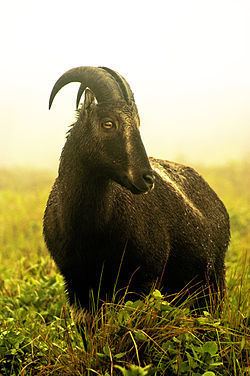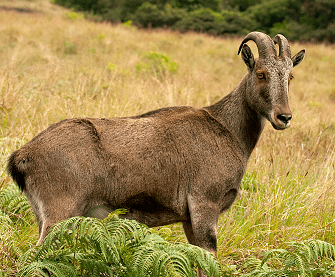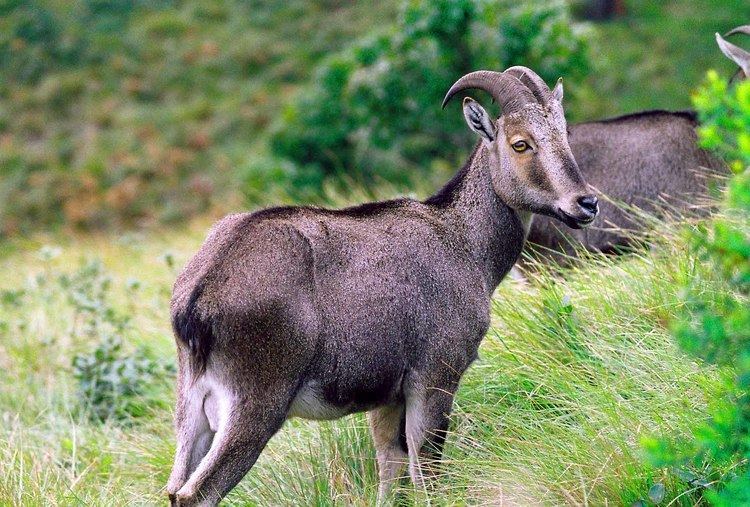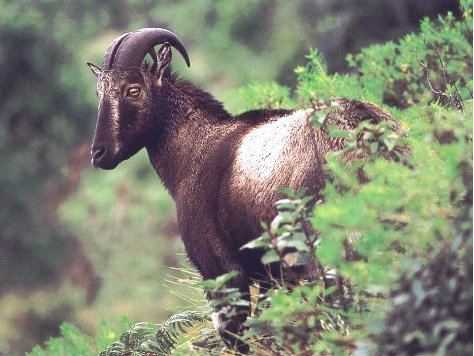Higher classification Nilgiritragus | Scientific name Nilgiritragus hylocrius Rank Species | |
 | ||
Genus NilgiritragusRopiquet & Hassanin, 2005 Similar Nilgiri langur, Lion‑tailed macaque, Himalayan tahr, Tiger, Arabian tahr | ||
Nilgiri tahr mountain goat horn fighting
The Nilgiri tahr (Nilgiritragus hylocrius) known locally as the Nilgiri ibex or simply ibex, is an ungulate that is endemic to the Nilgiri Hills and the southern portion of the Western Ghats in the states of Tamil Nadu and Kerala in southern India. It is the state animal of Tamil Nadu. Despite its local name, it is more closely related to the sheep of the Ovis genus than the ibex and wild goats of the Capra genus.
Contents
- Nilgiri tahr mountain goat horn fighting
- Varayadu nilgiri tahr
- Etymology
- Taxonomy
- Description
- Habitat and distribution
- Conservation
- References

Varayadu nilgiri tahr
Etymology

In the Tamil language it is called varaiaadu (வரையாடு), the term being composed of two Tamil words, wurrai a precipice, and aadu, a goat.In Malayalam it is pronounced as "Varayaadu" (വരയാട്). The ancient word in classical Tamil was "varudai" (வருடை: Natrinai, 359; Ainkurunuru, 287; Pattinappalai, 139). It was previously named Capra warryato by John Edward Gray.
Taxonomy

Its closest relatives are sheep (genus Ovis). Until 2005, it was placed with the Himalayan tahr (Hemitragus jemlahicus) and the Arabian tahr (Arabitragus jayakari) in the genus Hemitragus. However, it has recently been transferred to a new genus Nilgiritragus because it is genetically more similar to members of the genus Ovis than to other tahrs.
Description

The Nilgiri tahr is a stocky goat with short, coarse fur and a bristly mane. Males are larger than females and of darker color when mature. Both sexes have curved horns, reaching up to 40 centimetres (16 in) for males and 30 centimetres (12 in) for females. Adult males weigh 80 to 100 kilograms (180 to 220 lb) and stand about 100 centimetres (39 in) tall at the shoulder. Adult males develop a light grey area on their backs and are thus called "saddlebacks".
Habitat and distribution

The Nilgiri tahr inhabits the open montane grassland habitat of the South Western Ghats montane rain forests ecoregion. At elevations from 1,200 to 2,600 metres (3,900 to 8,500 ft), the forests open into grasslands interspersed with pockets of stunted forests, locally known as sholas. These grassland habitats are surrounded by dense forests at the lower elevations. The Nilgiri tahrs formerly ranged over these grasslands in large herds, before but hunting and poaching in the nineteenth century reduced their population.
Conservation
As few as 100 Nilgiri tahrs were left in the wild by the early 20th century. Since that time their numbers have increased somewhat; in a comprehensive study of the Nilgiri tahr population in Western Ghats, the WWF-India has put the population at 3,122. Their range extends over 400 kilometres (250 mi) from north to south, and Eravikulam National Park is home to the largest population. As per the Wildlife census conducted by Kerala forest department in association with volunteers from College of Forestry & Veterinary Science under Kerala Agricultural University, from April 24–28, 2014, number of animals in Eravikulam National Park has increased to 894 individuals. This is the highest ever count recorded in the national park, with the first census in 1996 finding only 640 tahrs. The other significant concentration is in the Nilgiri Hills, with smaller populations in the Anamalai Hills, Periyar National Park, Palni Hills and other pockets in the Western Ghats south of Eravikulam, almost to India's southern tip. A small populations of tahr numbering around 200 are known to inhabit the Boothapandi, Azhakiyapandipuram, Velimalai, Kulasekaram and Kaliyal Ranges in the Kanyakumari district of Tamil Nadu and another small herd of less than 30 animals is known to inhibit Ponmudi hills in Trivandrum district of Kerala
